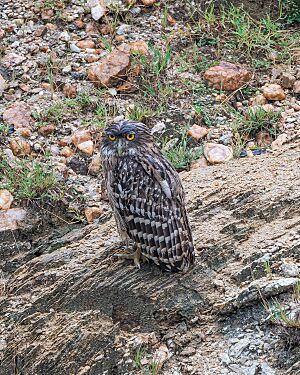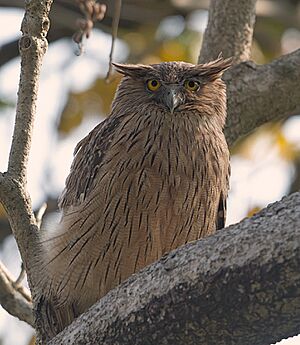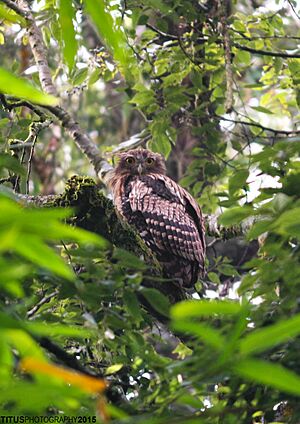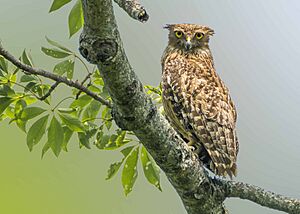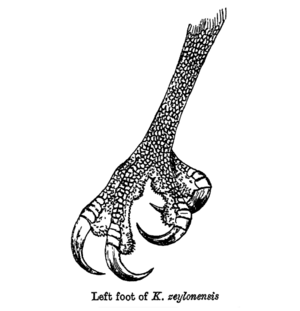Brown fish owl facts for kids
Quick facts for kids Brown fish owl |
|
|---|---|
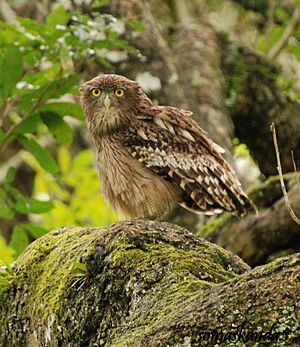 |
|
| Brown fish owl in Biligiriranga Hills | |
| Conservation status | |
| Scientific classification | |
| Subspecies | |
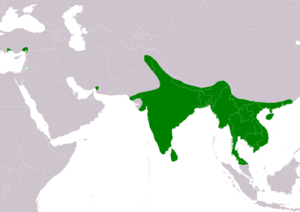 |
|
| Range of brown fish owl Resident Possibly Extant (resident) | |
| Synonyms | |
and see text |
The brown fish owl (Ketupa zeylonensis) is a type of fish owl. It belongs to the family of typical owls, called Strigidae. These owls live in a large area, from Turkey all the way to South and Southeast Asia. You can find them in forests and wetlands with trees.
Because they are found across such a wide area, they are listed as "Least Concern" on the IUCN Red List. This means they are not currently in danger of disappearing. Of the four types of fish owls, the brown fish owl is the most common and lives in the largest area. Their home range covers more than 7,000 kilometers (4,300 miles).
Contents
About the Brown Fish Owl
The brown fish owl was first officially described in 1788. A German scientist named Johann Friedrich Gmelin gave it the scientific name Strix zeylonensis. He based his description on drawings and notes from other naturalists.
Later, in 1830, a French naturalist named René Lesson placed this owl in a new group, or genus, called Ketupa. Today, scientists recognize four different types, or subspecies, of the brown fish owl:
- K. z. semenowi: Found from southeast Turkey to northwest India.
- K. z. leschenaulti: Lives across India, Myanmar, and west Thailand.
- K. z. zeylonensis: Found only in Sri Lanka.
- K. z. orientalis: Lives from northeast Myanmar to southeast China and the Malay Peninsula.
Scientists have studied the family tree of owls. They found that all Ketupa species are closely related.
Ancient Owls
Scientists have found old bones of owls from long ago. These bones suggest that brown fish owls, or similar owls, might have lived in the Mediterranean area. Some ancient owl bones were once thought to be a different species. But now, some scientists believe they might be an ancient type of brown fish owl.
These old owls were smaller than today's fish owls. They had longer legs and different wing shapes. It's thought they might have hunted land animals more than fish. The oldest owl remains found are about 5 million years old.
What They Look Like
The brown fish owl has noticeable ear tufts on its head. Its upper feathers are a reddish-brown color with dark streaks. Its belly is lighter, with wavy dark brown stripes. It has a white throat that can puff out.
Its face doesn't have a very clear shape. Its beak is dark, and its eyes are golden yellow. The owl's feet are yellow and do not have feathers. Young brown fish owls are usually lighter in color than adults. Female owls are a bit larger than males.
These owls can be from 48 to 61 centimeters (19 to 24 inches) long. Their wings can spread from 125 to 140 centimeters (49 to 55 inches) wide. Their weight can vary a lot, from 1.1 to 2.5 kilograms (2.4 to 5.5 pounds). This difference in size can be due to the different subspecies. Also, females are always bigger than males.
Compared to other owls, fish owls have shorter tails and a heavier build. They have larger wings and much longer legs. The bottom of their toes has a rough texture. This rough texture helps them grip slippery fish.
Unlike most owls, fish owls do not have soft feathers. This means their wing beats make sounds when they fly. Other owls have special feathers that help them fly silently to surprise prey. Fish owls also have a less deep facial disc. This shows that they rely more on sight than sound for hunting.
Different Types of Brown Fish Owls
- Sri Lankan brown fish owl (K. zeylonensis zeylonensis): This is the smallest and darkest type. It has a wing length of 35.5 to 40.5 centimeters (14 to 16 inches). One male was found to weigh about 1.1 kilograms (2.4 pounds).
- Common brown fish owl (K. z. leschenaultii): Found from India to Myanmar and Thailand. It is a medium color with lighter markings. Its wing length is 37 to 43 centimeters (14.6 to 17 inches).
- Western brown fish owl (K. z. semenowi): Lives from southern Turkey to Iran and Pakistan. It is paler and a bit larger than the common brown fish owl. Its wing length is 39.6 to 43.4 centimeters (15.6 to 17 inches).
- Eastern brown fish owl (K. z. orientalis): Found in northeast Myanmar, Vietnam, and southeast China. It is darker than the common brown fish owl. Its wing length is 36.5 to 45.7 centimeters (14.4 to 18 inches).
Where They Live
Brown fish owls live all year in most tropical and subtropical parts of Asia. This includes the Indian Subcontinent and Southeast Asia. They prefer forests and woodlands near streams, lakes, or rice fields. They mostly live in low areas, from open woods to thick forests.
In the Himalayas foothills, they can live up to 1,500 meters (4,900 feet) high. They often spend the day resting in bamboo or other large, shady trees. You might find them near water reservoirs, canals, or even on the edges of villages. They are always close to large bodies of water like rivers and lakes.
Because they are large hunting birds, you don't usually find many brown fish owls in one place. However, in Sri Lanka, they have adapted well to changes made by humans. This has helped them keep their numbers high there.
How They Live
The calls of the brown fish owl sound like a deep humming "boom-uh-boom" or a loud "huhuhuhuhuhuhu." Before breeding, they might make a three-part "tu-hoo-hoo" sound. Some say their call sounds like a distant Eurasian bittern.
Brown fish owls are mostly active at night. But sometimes, you can spot them during the day, especially on cloudy days. They often hunt by sitting on a rock or branch over water. They can also wade into shallow water. They catch food by gliding low over the water, almost touching it with their feet. Then they quickly extend their long legs to grab their prey.
They mainly eat fish and frogs. They also enjoy crabs and other water animals. They usually pick the biggest freshwater fish they can find. Unlike some other fish owls, brown fish owls often hunt in still water. In some areas, crabs are a very important part of their diet.
Brown fish owls might visit fish ponds or farms to find easy meals. They rarely eat land animals. But they have been known to eat snakes, lizards, insects, small mammals (like bats), and sometimes water birds. They have even been seen eating a large monitor lizard.
Brown fish owls sometimes compete for food with other large birds like Pallas's fish eagles. But brown fish owls eat more insects than eagles. If they are very hungry, brown fish owls will even eat dead animals. This is rare for owls.
Raising Young
Brown fish owls usually breed from November to April. This time of year is the dry season, which means water levels are low. This makes it easier for them to find crabs and fish. Owls do not build their own nests. So, brown fish owls are good at finding places to lay their eggs.
They often nest in shady spots in large trees, like mango or fig trees. They also use natural holes in riverbanks or old, eroded ravines. Sometimes, they nest near villages or along canals. They might even use old nests built by eagles or Old World vultures. Other nesting spots include rock ledges or caves.
A female owl usually lays one or two eggs. The eggs are about 5.8 by 4.9 centimeters (2.3 by 1.9 inches). The eggs hatch after about 38 days. The young owls leave the nest after about seven weeks. Young owls are mostly off-white when they are born. They become paler versions of the adults by their second year.
Dangers to Brown Fish Owls
In some places, like India, thousands of owls are harmed during certain festivals. This happens because of old beliefs about owls. Programs are now working to stop this practice.
Losing their natural homes is also a big threat. When their habitat is destroyed, brown fish owls leave the area. For example, in Israel, they are now rarely seen breeding. This is partly because dams have caused many waterways to dry up. Also, certain poisons used to control rodents can harm the owls or pollute their water.




